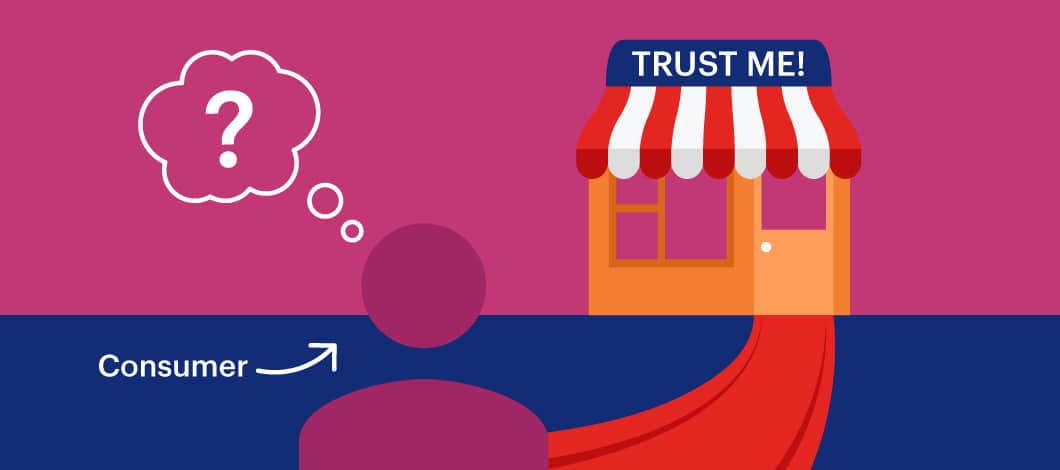Brand trust lays a foundation for strong customer relationships and repeat business. Learn how to gain customer trust and confidence.
We’ll cover what brand trust is, why it matters and 8 steps in building brand confidence:
- Appoint a brand manager
- Set brand trust goals
- Define brand trust metrics
- Develop a brand identity
- Become a trusted resource
- Offer smooth customer experience
- Deliver superior service
- Build social proof
We also will tell you some common trust-damaging mistakes to avoid. Learn how to build your brand’s reputation as a trustworthy provider.

What Is Brand Trust?
Brand trust can be defined as how confident your market feels in your company’s ability to deliver on what your marketing messages promises. This confidence can be expressed in terms of answers to questions such as:
- Does your target audience view your brand as honest and ethical?
- Does your target audience view your brand as an authoritative source of information on your market?
- Do your customers have confidence that your product or service does what it’s supposed to do?
- Do your customers feel satisfied with your support team’s service?
- Do your customers feel loyal to your brand?
- Would your customers recommend you to family and friends?
Becoming a trusted brand involves optimizing your performance in these types of areas in order to maximize consumer confidence.
Why Brand Trust Matters
Knowing how to build brand trust makes a big difference to your business for several reasons. First, consumer trust directly affects your marketing effectiveness. When your brand has a reputation as a trustworthy information source and reliable provider, prospects are more likely to pay attention to your social media posts and visit your website. Other sites and social media users are more likely to link to you and drive traffic to your site.
Brand trust impacts your sales. When prospects trust you, they’re more open to hearing your sales pitch. They’re less skeptical about your brand’s claims, more willing to consider your offer and more likely to be persuaded by your answers to sales objections.
Brand trust promotes repeat business. If your customer’s initial purchase from you proves a satisfying experience, they gain confidence in your products and services, making them more likely to buy from you again.
Brand trust promotes referrals. When your customers trust you, they become more likely to recommend you to their family and friends.

How Do You Build Trust With Customers?
Earning your market’s trust takes time and effort. You can accelerate the process by taking a systematic approach and following the 8 steps:
1. Appoint a Brand Manager
Building brand trust can take significant work. For optimal results, you need to plan your trust-building strategy, implement trust-building activity and monitor your results. To facilitate this, a qualified individual should be appointed to head your brand’s trust-building campaign.
This responsibility falls within the scope of a brand manager, which is a member of your marketing team responsible for optimizing your branding campaign to match your target market. Duties of a brand manager typically include:
- Developing your branding strategy, including your brand vision, value proposition and style guidelines
- Planning communication which represents your brand, including website and social media posts
- Supervising the development of promotional material to communicate your branding message
- Monitoring online conversations about your brand
The full scope of a brand manager’s duties goes beyond just building brand trust, but nurturing confidence in your company is one of the tasks which falls within their range of responsibilities. If you already employ a brand manager or someone who serves a similar role, you can include building brand trust as one of their assignments.
If you don’t have a brand manager, you can assign someone on your marketing team to handle general brand management responsibilities or the specific task of building brand trust. Alternately, you can hire a specialist with brand management training or outsource your brand management to an experienced marketing agency.
2. Set Brand Trust Goals
Your brand manager can help your marketing team develop brand trust goals. Verbalizing your trust-building goals makes your objectives concrete and enables you to plan steps and evaluate progress.
Goals which promote brand trust-building can include:
- Redefining your branding message to communicate trustworthiness
- Publishing content to position your brand as an authority
- Building your site’s authority by increasing links back to your blog
- Improving customer satisfaction
- Generating more positive online reviews of your product
- Increasing referral rates
Set goals which support your overall marketing and branding strategy.
3. Define Brand Trust Metrics
To make your brand trust goals measurable, you should express them in terms of metrics which quantify them, called key performance indicators (KPIs). Using KPIs to quantify your brand trust goals allows you to determine how close you are to achieving your objectives, track progress and evaluate whether your actions are achieving results.
Examples of KPIs you can use to quantify brand trust goals include:
- Review volume and quality: how often do customers rate your brand on review sites, and what is your average review rating?
- Organic traffic: how many visitors arrive on your blog from organic search results?
- Backlink volume and quality: how many sites link back to your site, and what is their Domain Authority (DA), a search engine-ranking score created by Moz, compared with sites linking to your competitors?
- Social shares: how often do social media users share your content?
- Customer service metrics: how long on average do your customers have to wait before receiving support?
- The Net Promoter Score (NPS), a customer-service metric developed by management consulting firm Bain that asks: How likely are customers to recommend a brand to family and friends on a scale of 0 to 10?
These are just some illustrative examples. There are many other metrics you could use. Select KPIs which match your goals, and track them on a regular basis to monitor how well your trust-building activities are working.
4. Develop a Brand Identity
Customer trust reflects your market’s perception of your brand’s identity. By consciously defining and communicating your brand’s identity, you can promote consumer trust.
One way to define your brand’s identity is by formally stating your company’s beliefs, values, mission and vision:
- What is your company’s business philosophy?
- What values do you prioritize with respect to your employees, customers and market?
- What is the purpose of your company?
- Where do you see your brand in the future?
Answering these types of questions and sharing them as formal statements on your website can help communicate your brand identity and why customers should trust you.
Another way to develop your brand identity is by developing a unique value proposition (USP). A USP is a concise statement of:
- What value your company offers your customers
- Why they should want it
- Why it differs from that offered by rival brands
Your USP tells customers why they should buy from you instead of someone else. Trustworthiness can be one component of a USP.
A third way to communicate brand identity is through stories. Your company’s history, stories about your staff and stories about your customers can all serve to communicate a message of trust.
In the context of the COVID-19 pandemic, a specific way to build brand trust is by letting customers know what steps you’ve taken to accommodate any new needs they may have. For example, many auto insurance providers have reduced their rates or extended payment deadlines to reflect reduced vehicle use and accommodate financially distressed customers.
These kinds of efforts let customers know you’re aware of their needs and you’re working to support them during a difficult time.

5. Become a Trusted Resource
An effective strategy for building consumer trust online is to publish or sponsor content which positions your brand as an authoritative provider of reliable information.
There are a number of ways you can do this, including:
- Publish original market research based on your own internal data or surveys commissioned by you
- Comment on original research done by other authorities
- Provide practical how-to information solving problems which your customers face
- Broadcast multimedia content through videos or podcasts
- Share content from other authorities through your blog, email list and social media profiles
- Offer exclusive interviews with recognized experts
- Host online events such as webinars and panel discussions
For best results, develop content based on research into your target market’s needs and keyword interests, and publish on a regular basis to promote brand awareness.
6. Offer Smooth Customer Experience
Customers feel more positive about your brand if they enjoy a smooth user experience (UX) when visiting your website. You can promote a better UX by taking steps such as:
- Making your site mobile-friendly so that it is easy to see and navigate on smartphones
- Making your site responsive so that its appearance adjusts for users on all devices and screen sizes
- Keeping your most important navigational links on top of your home page
- Providing navigational menus and search tools which make it easy for visitors to find the information they want
- Allowing returning customers to stay logged in for easier checkout
- Avoiding annoying distractions such as pop-ups which interrupt the UX
Your web development and design team can work with your marketing and sales team to help ensure that your website provides a smooth experience for visitors and customers.
7. Deliver Superior Service
Customers trust you more when you deliver great service. You can improve your service by taking steps such as:
- Providing self-service and automated support options to reduce customer wait time
- Extending no-obligation trial offers if applicable to your industry
- Offering free shipping for qualifying orders
- Promising money-back guarantees
- Offering discounts for customer loyalty
To evaluate your customer service performance objectively, use KPIs to track your performance in specific areas. For instance, you might set a goal of making sure customers seeking phone support are not left on hold more than 2 minutes without speaking to a representative. You can then track your average wait time to see how close you come to achieving this goal and determine which adjustments you should make.
8. Build Social Proof
Buyers listen to what your customers say about your brand when deciding whether to trust you. You can encourage consumer trust by providing social proof from other customers vouching for your brand. Examples of social proof include:
- Testimonials from your customers
- Endorsements from authorities or celebrities
- Reviews posted on your site or other sites
- Mentions of your brand in social media or in blogs and articles
Collect examples of social proof which you can feature on your website and in other marketing material.
Trust Damaging Mistakes to Avoid
In addition to following best practices for building customer trust, it’s also important to avoid mistakes that can damage consumer confidence in your brand. Some of the worst mistakes you can make include:
- Misusing customer data
- Making it difficult for customers to communicate with you
- Wasting customers’ time
Avoiding common blunders in these areas can keep you from losing customer trust you’ve worked hard to build.
Don’t Misuse Customer Data
Customers will quickly lose confidence in you if you misuse personal data they entrust you with. Avoid practices such as:
- Requesting excessive or intrusive contact information on opt-in forms
- Sharing customer data with third-party spammers
- Sending customers an excessive amount of promotional material
- Sending content which is irrelevant to the needs of your email subscribers or social media followers
- Neglecting to protect customer data from security breaches
Avoid these or any other practices which would lead customers not to trust you with their data. Make every effort to let customers know that they can be confident in entrusting you with their information.
Don’t Make It Hard for Customers to Communicate With You
Communication barriers can become obstacles to trust. Avoid practices which make it difficult for customers to communicate with you, such as:
- Failing to provide communication channels preferred by your target market, such as telephone or email support
- Burying contact information on your website in a place which makes it challenging for customers to find
- Providing automated support only without allowing customers the option of speaking to a human representative
Strive to make it as easy as possible for customers to communicate with you.
Don’t Waste Your Customer’s Time
Customers can develop a negative perception of your brand if they feel like you don’t value their time. Avoid practices which can waste your customers’ time, such as:
- Allowing customers to wait in long queue lines in chatbot windows or phone menus without a response from your automated or human support systems
- Neglecting to return phone calls or emails for several business days
- Asking customers to repeat information they’ve already provided
Take whatever steps you can to speed up the support process for your customers. Faster service means more satisfied customers who have more trust in your brand.
Build Brand Trust to Cultivate Better Customer Relationships
Building consumer trust provides a firm basis for nurturing stronger relationships with your customers to generate loyalty, repeat business and referrals. To build consumer trust, you may need to invest in improving your marketing, web design and customer service strategies.
If you need financing to pursue these improvements, consider looking into securing business loans, lines of credit or merchant cash advances. Investing in building trust can pay off in customer satisfaction and retention.










